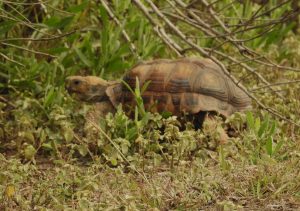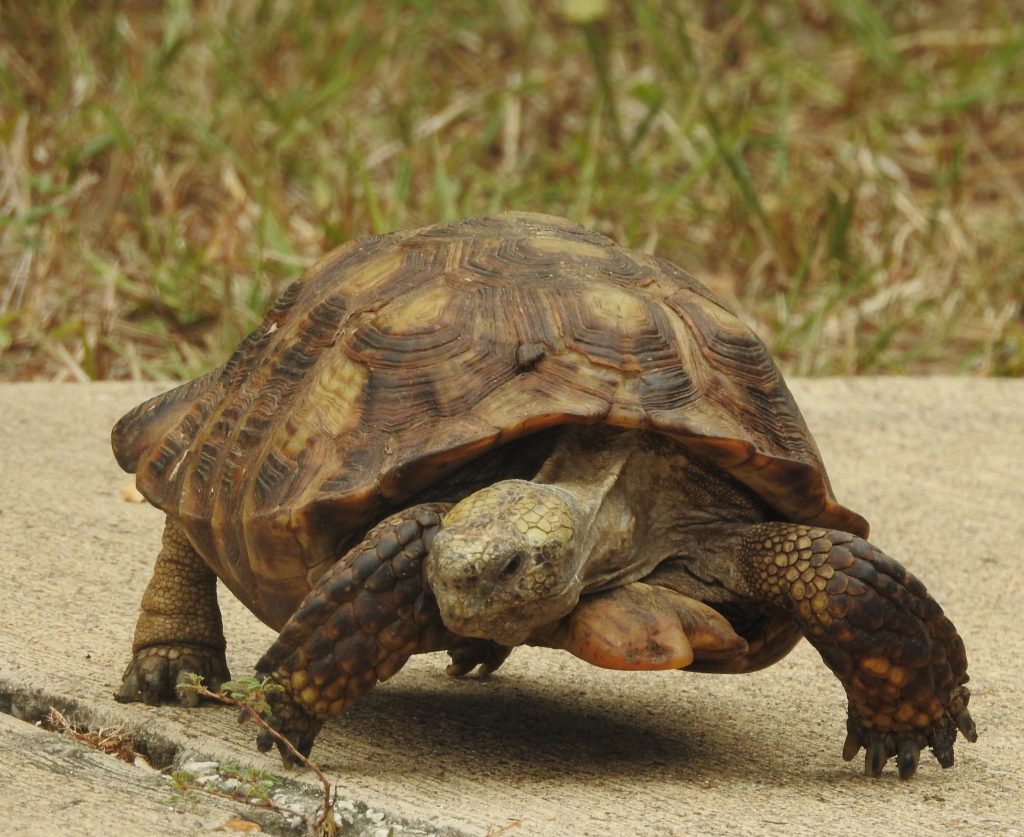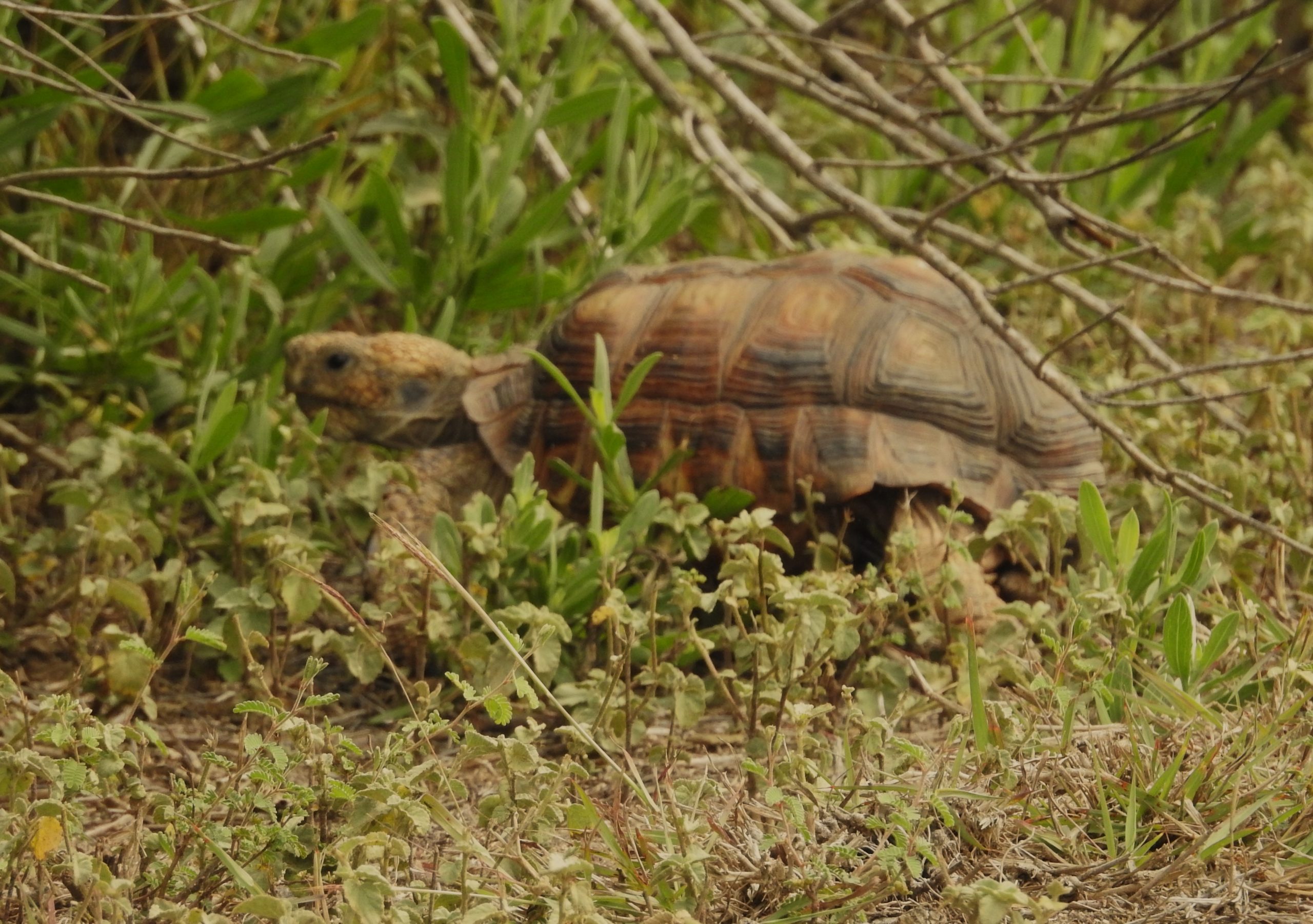by M. Kathy Raines
Like an actor parting the curtains, a Texas tortoise took the stage from behind foliage near the visitors’ center at Palo Alto Battlefield one steaming August day, its curvy forelegs pigeon-toed, its back ones, elephantine.

With glee, I dropped purse and backpack and took cell phone photos, then camera shots, approaching nearer and nearer. But the tortoise, nonplussed and unstartled, continued its munching till I was almost upon it. Since then, I’ve observed others of its peers, with their instinctive knowledge they have little to fear from the likes of me.
Texas has designated the Texas tortoise (Gopherus berlandieri), its sole native tortoise (a nonaquatic turtle in the family Testudinidae) a threatened species, largely due to habitat fragmentation and loss resulting from the growth of business parks and residential neighborhoods. Rare are homeowners who nurture tortoise-attracting prickly pear in their backyards, though some do cultivate wildlife-drawing native plants, including trees like ebony, retama and huisache. Requiring a range from between five and ten acres, this tortoise thrives in dense semi-arid to arid chaparral, grasslands and thornscrub in roughly the lower third of Texas. It can withstand an occasional freeze, but not sustained ones.
The smallest North American tortoise, its domed, tannish or brown shell—which encloses its skeletal system—bears yellowish orange scutes, or plates, and reaches about 8 ½ inches in length. The tortoise’s head appears wedge-shaped, and its feet are unwebbed. While a female’s bottom shell, or plastron, is flat, the male’s is concave, which apparently facilitates sexual intercourse. Both sexes bear a gular (throat) horn, which is a Y-shaped extension of the plastron under the neck, though the male’s is more prominent. He sometimes slips it under an intruder’s shell, tipping his opponent upside down and rendering him helpless, perhaps fatally so.

As its species name, Gopherus, indicates, this tortoise is a digger. Using its forelegs, gular scute and shell sides, it moves soil and debris to form a pallet, or bed, usually near a cactus, tree or shrub, where it rests or retreats from excessive temperatures. Tortoises, according to biologist David Attenborough, cool themselves in extremely hot weather by wetting their heads with saliva, sometimes even urinating over their back legs.
Especially fond of succulents, this forager’s thick scales shield it from thorns as it tears into the juicy pulp of a tuna (fruit) of a prickly pear, its pads and flowers. It also eats other plants and sometimes insects, snails and bones, largely hydrating itself with its diet. While the tortoise avoids overgrazed lands, it may benefit from those that have been mildly grazed, which encourages the proliferation of cacti.
Though this threatened tortoise may live to age 60, its reproduction rate is slow. It doesn’t breed until it’s ten or fifteen years old. Once or twice a year, usually between April and July, the female digs a shallow nest in sandy soil, where she deposits two or three eggs, covers them and departs. Nestlings, which hatch in from 88 to 100 days, mature slowly and face multiple threats—roadrunners, snakes, feral hogs and, sadly, as with adult tortoises, automobiles.
A healthy population of Texas tortoises indicates the wellbeing of other wildlife. Therefore, researchers, beginning in 2008, have been monitoring Texas tortoises at Palo Alto Battlefield, locating, marking, and analyzing their carapace sizes, among other statistics. As of 2020, they have found 200 individuals, 8 to 10 for each hectare (2.47 acres), suggestive of a vital population. A few tortoises have been tagged with radio transmitters and tracked monthly, a short-term project designating their habits and preferences. Each researcher stakes out a certain area and remains there for two hours. They take photos and, with a tiny drill, bore holes on outer ends of front and back scutes, which creates a code for later identification. A short wire mesh fence shields tortoises from traffic outside Palo Alto.
In 2021, then student Autumn R. Coronado, as part of the Urban Ecology Texas Tortoise Project at Texas A&M University in Kingsville, studied the tortoises at Harlingen’s 55-acre Ramsey Park, wherein she and others attached radio-transmitters to five tortoises, monitoring them from May through October. Since the mid-1990’s, local naturalists have been removing invasive plants from Ramsey—which was previously a landfill—and replanting them with natives, efforts which have handsomely paid off in attracting native wildlife, including Texas tortoises. This study revealed that tortoises stayed closest to restored areas and used and consumed native species more than nonnatives. Heartening to know is that the tortoises—presumably rare or absent during Ramsey’s landfill days—discovered comfortable, useful passageways through town to this urban refuge, highlighting the importance of such corridors through private land and parks.

One may not capture a Texas tortoise without procuring a Scientific Collecting Permit from Texas Parks and Wildlife Department (TPWD). However, one should move a tortoise to safety from the middle of a roadway. Anyone finding a tortoise in a yard or other unsuitable location should contact local rehabbers: http://www.tpwd.state.tx.us/huntwild/wild/rehab/.

